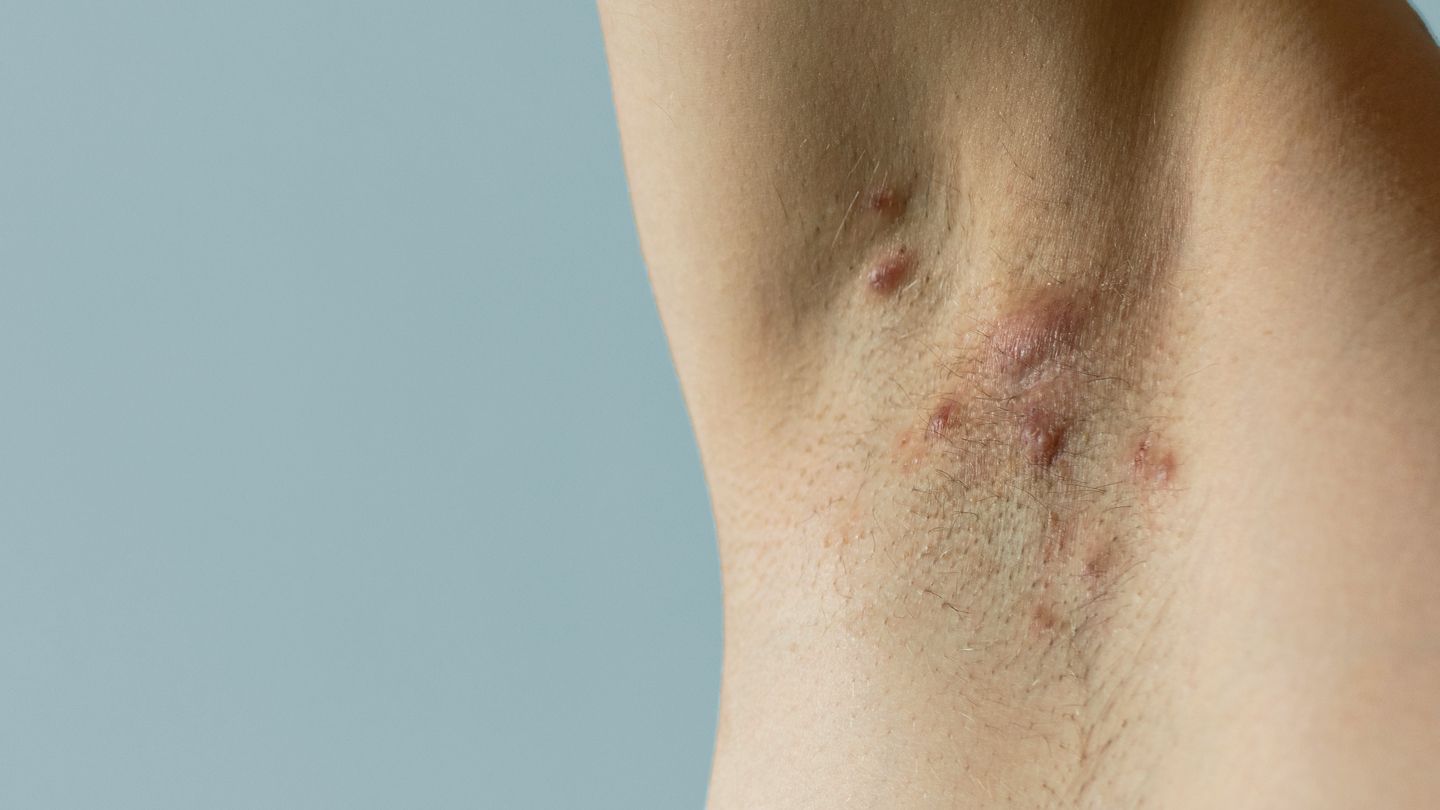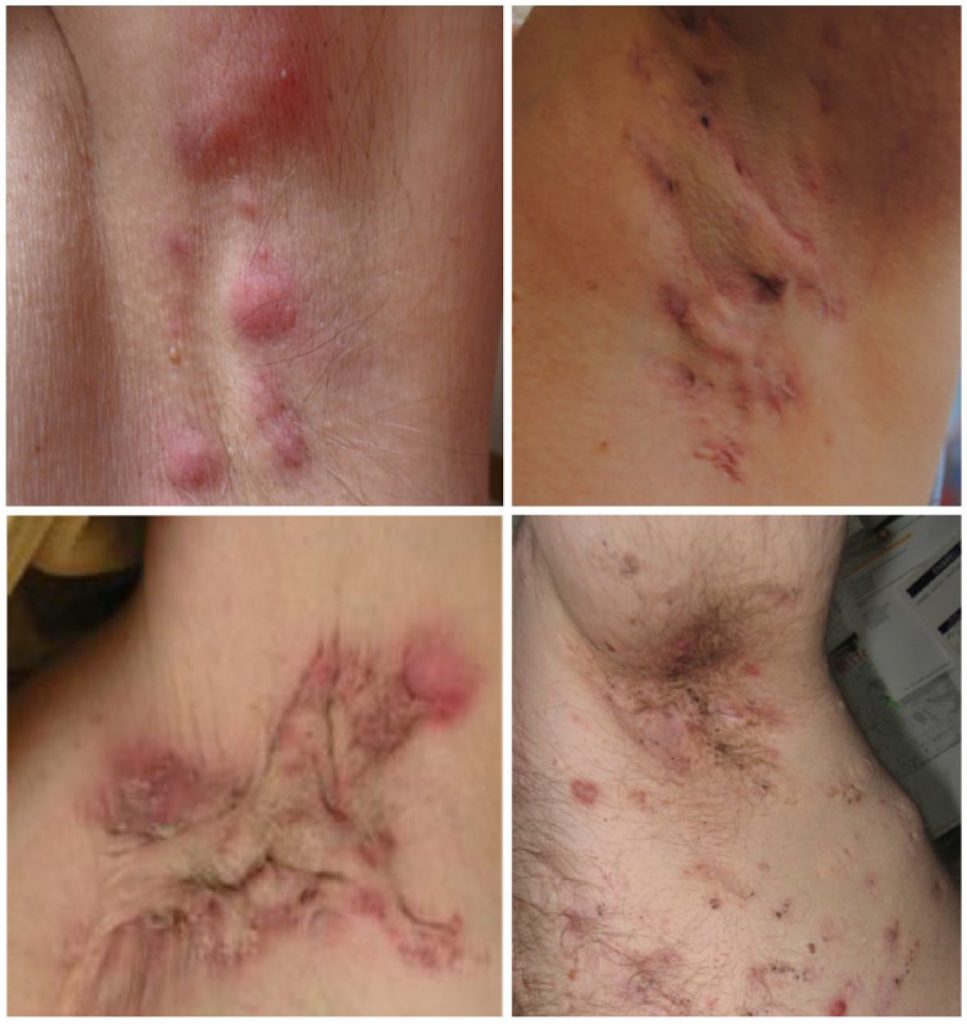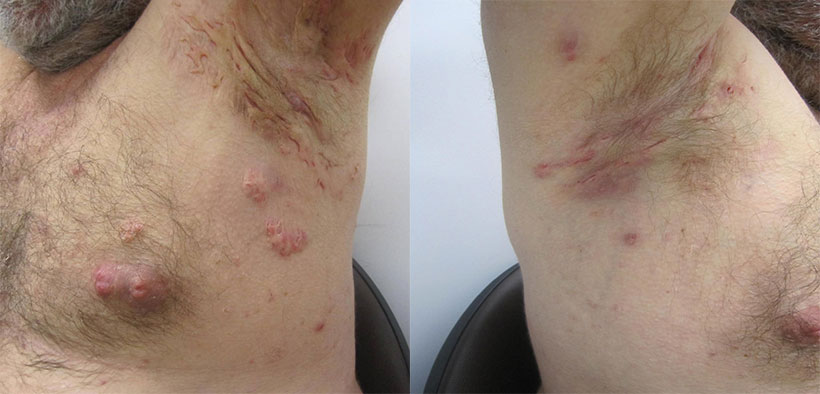
- What is hidradenitis suppurativa?
Hidradenitis suppurativa (HS), also called acne inversa, is a chronic inflammatory skin condition that affects apocrine gland-bearing skin in the axillae, groin, and under the breasts. It is characterised by persistent or recurrent boil-like nodules and abscesses that culminate in a purulent discharge, sinuses, and scarring.
HS can have a significant psychological impact, and many patients suffer from anxiety, depression, and impairment of body image.

- Who gets hidradenitis suppurativa?
Hidradenitis suppurativa often starts at puberty, is most active between the ages of 20 and 40 years, and in women can resolve at menopause. It is three times more common in females than in males. Associations and risk factors include:
– Family history of HS; 30–40% report at least one other family member affected
– Obesity and insulin resistance (metabolic syndrome)
– Cigarette smoking
– African ethnicity
– Follicular occlusion syndrome: acne conglobata, dissecting cellulitis, pilonidal sinus
– Inflammatory bowel disease, particularly Crohn disease
– Other skin disorders: psoriasis, acne, hirsutism
– Comorbidities: hypertension, diabetes mellitus, dyslipidaemia, thyroid disorders, arthropathies, polycystic ovary syndrome, adverse cardiovascular outcomes
– Drugs: lithium, sirolimus, biologics
– Syndromes
* PAPA syndrome
* PASH syndrome (pyoderma gangrenosum, acne, suppurative hidradenitis)
*PAPASH syndrome (pyogenic arthritis, pyoderma gangrenosum, acne, suppurative hidradenitis).

- What causes hidradenitis suppurativa?
Although ‘hidradenitis’ implies an inflammatory disease of the sweat glands, we now know that HS is an autoinflammatory syndrome. The exact pathogenesis is not yet understood. Factors involved in the development of acne inversa include:
– Follicular occlusion
– An abnormal cutaneous or follicular microbiome
– Release of pro-inflammatory cytokines
-Inflammation causing rupture of the follicular wall, destroying sebaceous and apocrine glands and ducts.
- What are the clinical features of hidradenitis suppurativa?
Acne inversa can affect single or multiple areas in the axillae, neck, inframammary fold, and inner upper thighs. Anogenital involvement most commonly affects the groin, mons pubis, vulva, scrotum, perineum, buttocks, and perianal folds.
HS is characterised clinically by:
– Open double-headed comedones
– Painful firm papules and nodules
– Pustules, fluctuant pseudocysts, and abscesses
– Draining sinuses linking inflammatory lesions
– Hypertrophic and atrophic scars.
- What are the complications of hidradenitis suppurativa?
Complications of HS can include:
– Secondary infection
– Psychological effects and negative impact on quality-of-life
– Pyogenic granuloma
– Lymphoedema: female genital
– Squamous cell carcinoma: male anogenital
– Anaemia of chronic disease.
- What is the treatment for hidradenitis suppurativa?
For a detailed evidence-based review of treatment for HS, see Management of hidradenitis suppurativa: an Australasian consensus statement. The following provides important general measures and additional medical treatments.
* General measures
General measures for treating patients with hidradenitis suppurativa include:
– Weight loss
– Smoking cessation
– Loose fitting clothing
– Absorbent dressings
– Analgesics
– Management of anxiety and depression; including reassurance that the condition is not infectious or a results of poor hygiene.
* Specific medical measures
Specific medical measures for treating hidradenitis suppurativa include:
– Topical treatments
+ Triclosan/benzoyl peroxide wash
+ Topical clindamycin phosphate 1% with benzoyl peroxide
+ Topical antibiotics: fusidic acid, dapsone, metronidazole.
– Systemic treatments
+ Antibiotics for bacterial infections
+ Other oral treatments : hormonal therapies, immunomodulatory treatments, biologics, other systemic medical treatments used off-label.
– Surgical.